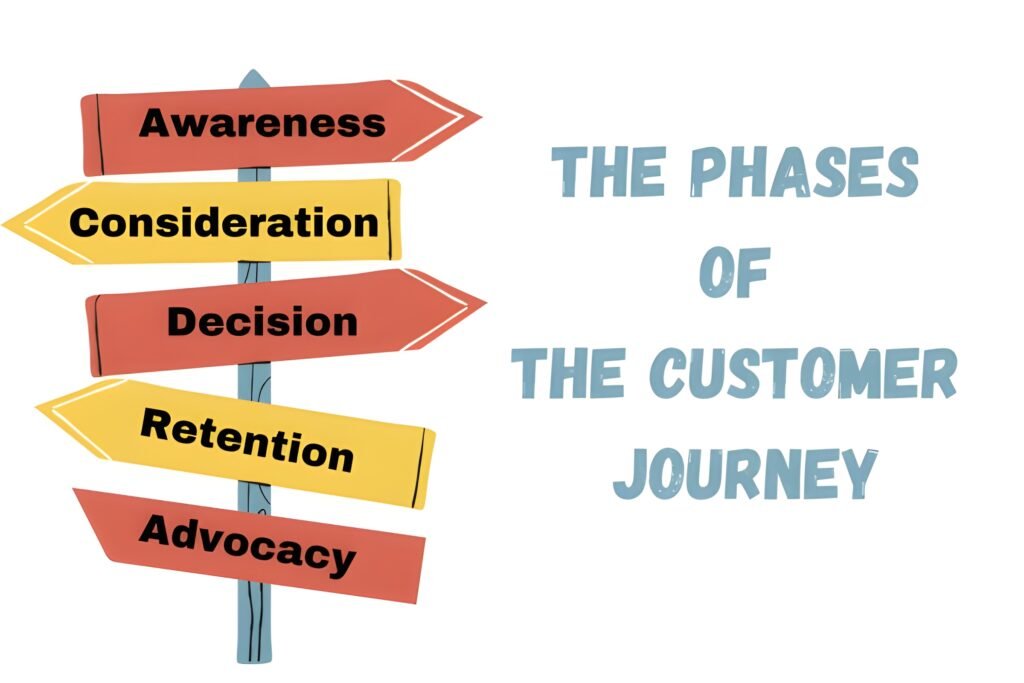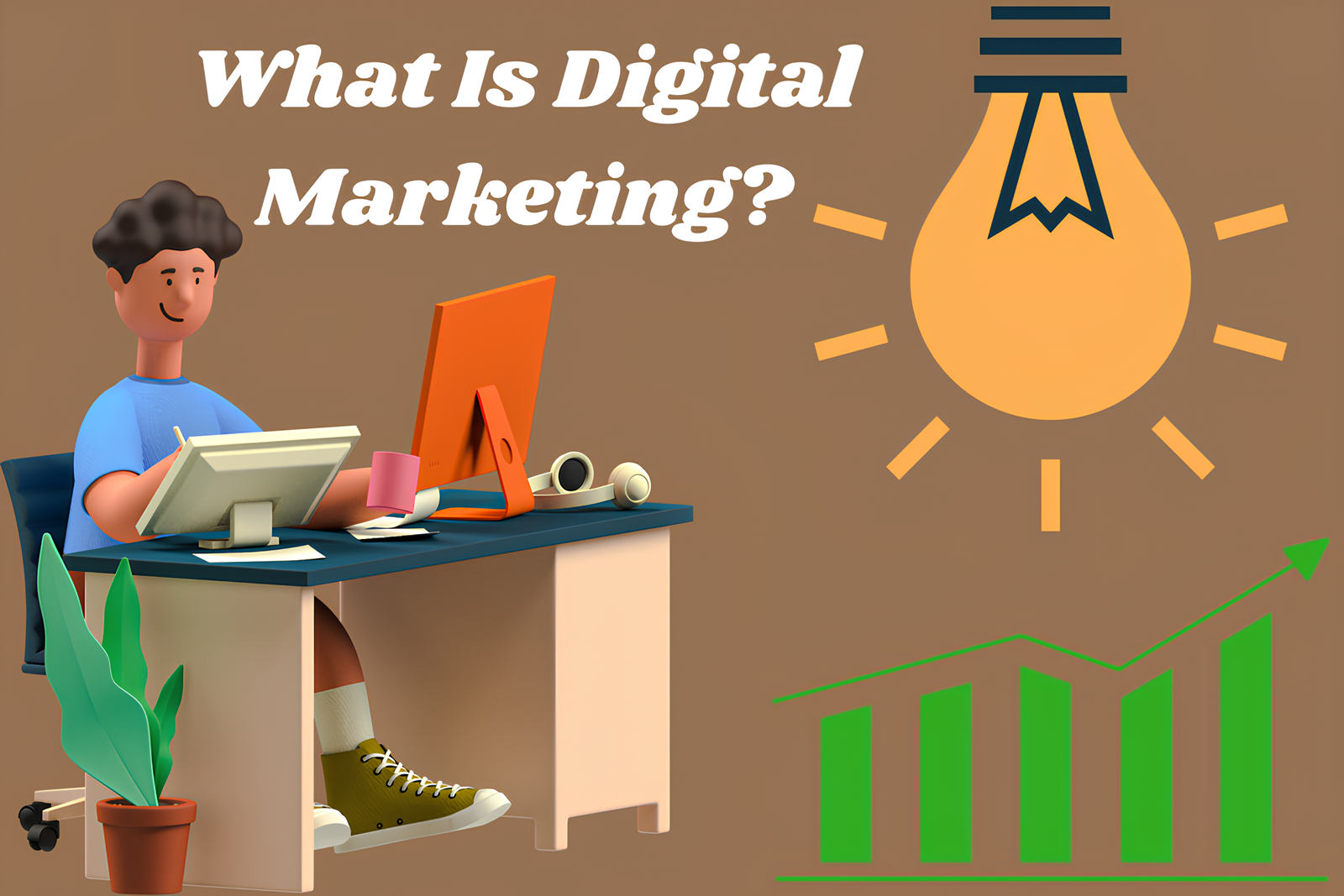Customer Journey, In today’s highly competitive and customer-centric marketplace, businesses can no longer rely solely on great products or services to attract and retain customers. Consumers now have an abundance of choices, and their buying decisions are influenced by multiple factors, from brand reputation to online reviews and personalized experiences. This is Where Understanding the Customer Journey becomes essential.
The customer journey refers to the complete experience a person has with a brand, from the initial awareness stage to post-purchase interactions. It encompassesevery touchpoint and interaction a customer has with a business, whether through online research, social media, customer support, or in-store experiences.
By mapping and optimizing the customer journey, businesses can identify pain points,enhance engagement, and create personalized experiences that drive customer satisfaction and loyalty. A Well-structured customer journey not only improves conversions but also strengthens brand reputation and encourages repeat purchases.
In this blog, we’ll explore the different stages of the customer journey, why it matters, and how businesses can effectively optimize it to ensure long-term success.
- What is the CustomerJourney?
- Why is the Customer Journey Important?
- The Phases of the Customer Journey
- The Benefits of Customer Journey Mapping in Detail
- 1. Improved Customer Experience
- 2. Increased Customer Engagement
- 3. Higher Conversion Rates & Reduced Drop-Offs
- 4. Stronger Brand Loyalty & Customer Retention
- 5. Better Customer Insights & Data-Driven Decisions
- 6. More Effective Marketing Campaigns
- 7. Increased Word-of-Mouth Marketing & Brand Advocacy
- 9. Improved Customer Support & Problem Resolution
- 10. Higher Return on Investment (ROI)
- How can you built Customer Journey?
- Conclusion
What is the CustomerJourney?

The customer journey refers to the complete experience a customer has with a brand, from the moment they become aware of a product or service to the point where they make a purchase—and even beyond. It encompasses all the interactions,emotions, and decisions a customer goes through while engaging with business.
Unlike traditional sales funnels, which focus mainly on the conversion process, the customer journey takes a holistic approach by considering every step and touchpoint that influences the customer’s perception and decision-making process. It recognizes that modern customers interact with brands through multiple channels—websites, social media, email, advertisements, and even in-person experiences—before making a purchase.
Why is the Customer Journey Important?

Understanding and optimizing the customer journey is crucial because:
- Enhances Customer Experience: A Smooth and personalized journey improves customer satisfaction and loyalty.
- Increases Conversion Rates: Addressingcustomer pain points and streamlining their experience leads to higher sales.
- Builds Stronger Relationships: Apositivejourney encourages long-term engagement and repeat purchases.
- Identifies Areas for Improvement: Mapping the journey helps businesses pinpoint gaps and refine their strategies.
- Boosts Brand Reputation: Awell-craftedcustomer journey encourages advocacy and word-of-mouth marketing.
The Phases of the Customer Journey

The customer journey consists of several distinct stages that outline how a customer interacts with a brand from the first moment of awareness to becoming a loyal advocate. Understanding these phases helps businesses optimize customer experiences, improve engagement, and drive long-term success.
1. Awareness Stage (Discovery Phase)
What Happens in This Stage?
In this Stage, The customer first becomes aware of a need, problem, or desire and begins looking for potential solutions. They might not yet know about your brand or offerings, but they’re actively searching for information.
Key Touch Points:
- Social media posts and advertisements Search engine queries (Google, Bing, etc.)Blogs, articles, and educational content.
- Word-of-mouth recommendations
- Influencer marketing
- Press releases and media coverage
Business Strategy for This Stage:
- Create high-quality content (blogs, videos, infographics) that educate potential customers about their problem and introduce your brand as a solution.
- Optimize SEO strategies so your brand appears when users search for relevant keywords.
- Use paid advertising (Google Ads, FacebookAds) to target potential customers based on their interests and behaviors.
- Engage with users on social media to build awareness and establish credibility.
2. Consideration Stage (Research Evaluation Phase)
What Happens in This Stage?
In this Stage, The customer now understands their problem and is actively researching potential solutions.They are evaluating different brands, comparing features, pricing, and reviews before making a decision.
Key Customer Actions:
Comparing products or services Reading online reviews and customer testimonials Watching product demos or tutorials Asking for recommendations from peers or online communities Engaging with brands through inquiries(chatbots, email, phone calls).
Brand Touch Points:
Product comparison pages and FAQs Customer testimonials and case studies Webinars, live demos, and explainer videos Email marketing campaigns with personalized recommendations Free trials, samples, or consultation offers.
Business Strategy for This Stage:
- Provide Clear Product/Service Information: Ensure customers have easy access specifications, benefits, and unique selling points.
- Showcase Customer Reviews and CaseStudies: Build trust by highlighting positive experiences from real customers.
- Offer Free Demos or Trials: Let customers experience your product before committing.
- Engage Through Email Marketing: Sendpersonalized recommendations and follow-ups.
- Interactive Chatbots and Customer Support: Answer queries instantly to help customers make informed decisions.
3. Decision Stage (PurchasePhase)
What Happens in This Stage?
In This Stage, The customer is ready to make a purchase but may need a final push to commit. Theymightstill have some hesitations, such as pricing concerns, trust issues, or doubts about product suitability.
Key Customer Actions:
Adding products to cart or booking service Searching for discount codes or promotions Checking refund and return policies, customer support for last-minute clarifications Reviewing payment options and financing plans.
Brand Touch Points:
Product pages with pricing and features clearly outlined Secure and seamless checkout process Special offers, discounts, and limited-time deals Trust signals (secure payment options, warranties, return policies) Abandoned cart email reminders.
Business Strategy for This Stage:
- Simplify the Buying Process: Ensure The Checkout process is smooth, quick, and user-friendly.
- Use Urgency and Scarcity Techniques: Offer Limited-time discounts or exclusive deals.
- Provide Multiple Payment Options: Accept Credit cards, PayPal, BNPL, Google Pay, Phone Pe (Buy Now, PayLater) services.
- Offer Money-Back Guarantees or Warranties: Reduce risk and Increase trust.
- Send Cart Abandonment Reminders: Encourage customers to complete their purchase.
4. Retention Stage (Post-Purchase & LoyaltyPhase)
What Happens in This Stage?
In This Stage, After the purchase, the customer’s experience with the brand determines whether they will buy again, leave a review, or switch to a competitor.T his stage is critical for customer satisfaction and retention.
Key Customer Actions:
Receiving order confirmations and shipping updates Using the product or service for the first time Contacting customer support for troubleshooting Providing feedback or ratings Evaluating their overall purchase experience.
Brand Touch Points:
Order confirmation emails and follow-up messages Customer service interactions (chat, phone, email support) Onboarding guides and video tutorialsLoyalty programs and personalized recommendations Surveys and feedback collection.
Business Strategy for This Stage:
- Send Post-Purchase Follow-Ups: Thank Customers and provide helpful resources.
- Offer Excellent Customer Support: Provide Fast and effective solutions to any issues.
- Create a Loyalty Program: Reward repeat customers with discounts or exclusive perks.
- Request Feedback and Reviews: Encourage customers to share their experience.
- Continue Engaging with Customers: Send personalized offers and product recommendations.
5. Advocacy Stage (Brand Evangelism & Word-of-Mouth Marketing)
What Happens in This Stage?
In This Stage, A truly satisfied customer transforms into a brand advocate, sharing their positive experiences with others. They may refer friends,write glowing reviews, or promote your brandon social media.
Key Customer Actions:
Writing reviews on Google, Yelp, or Trust pilot Sharing their experience on social media Participating in referral programs Creating user-generated content (photos, testimonials, case studies) Engaging with the brand’s community (forums, social media groups).
Brand Touch Points:
Review request emails and social media engagement Referral programs and rewards for sharing Customer appreciation initiatives (exclusive events, VIP perks) Social media interactions and reposting user content Personalized thank-you messages.
Business Strategy for This Stage:
1. Encourage Reviews and Testimonials: Provide incentives for customers to leave feedback.
2. Launch a Referral Program: Rewardcustomers for bringing in new buyers.
3. Feature User-Generated Content: Showcase Real customers using your products/services.
4. Build a Community: Create groups or forums where customers can interact.
5. Celebrate Your Advocates: Recognize loyal customers and brand ambassadors.
The Benefits of Customer Journey Mapping in Detail

Understanding and mapping the customer journey is essential for businesses aiming to deliver an exceptional customer experience. It Helps companies visualize how customers interact with their brand, identify pain points, and optimize every touchpoint for better engagement, retention, and loyalty. Below Are the key benefits of customer journey mapping, explained in detail.

1. Improved Customer Experience
How It Helps?
Customer journey mapping provides a holistic view of how customers interact with a brand across multiple touchpoints (website, social media, customer service, in-store, etc.).
It helps businesses understand the emotions, frustrations, and expectations of customers at each stage.
By identifying areas of friction (long wait times,complex checkout processes, poor support), businesses can make improvements so seamless and positive experience.
Example:
A retail brand notices that customers often abandon their shopping carts due to high shipping fees. By offering free shipping for orders above a certain amount, they improve the purchase experience and increase conversions.
2. Increased Customer Engagement
How It Helps:
Mapping the customer journey allows businesses to create targeted and personalized content that keeps customers engaged.
Companies can use insights to send timely and relevant emails, social media messages, and special offers based on where customers are on their journey.
Engaged customers interact more with brands,stay longer, and are more likely to convert.
Example:
A SaaS company sends automated onboarding emails with video tutorials to new users. This Helps customers understand how to use the software effectively, increasing engagement and reducing churn.
3. Higher Conversion Rates & Reduced Drop-Offs
How It Helps:
Understanding where potential customers dropoff in their journey allows businesses to address those issues and streamline the buying process.
Optimizing landing pages, improving website navigation, and simplifying checkout processes lead to higher conversion rates.
Offering personalized recommendations based on customer behavior increases the likelihood of purchase.
Example:
An ecommerce store notices that many customers abandon their carts at the payment page. They introduce a guest checkout option, multiple payment methods, and alivechat assistant—leading to a 20% increase in completed purchases.
4. Stronger Brand Loyalty & Customer Retention
How It Helps:
A positive and frictionless customer journey makes customers more likely to return for future purchases.
Businesses can implement loyalty programs, personalized rewards, and exclusive offers to encourage repeat business.
Providing exceptional post-purchase support, follow-ups, and personalized recommendations builds long-term relationships.
Example:
A coffee subscription company offers personalized discounts and birthday gifts to repeat customers. This creates emotional engagement and strengthens brand loyalty.
5. Better Customer Insights & Data-Driven Decisions
How It Helps:
Customer journey mapping allows businesses to collect valuable data on customer behavior, preferences, and pain points.
Companies can track key metrics like website traffic, email open rates, cart abandonment, and customer feedback to improve marketing strategies.
Predictive analytics can help businesses anticipate customer needs and deliver proactive solutions.
Example:
A financial services company analyzes customer interactions and discovers that users frequently visit their loan calculator page but don’t apply. They add an interactive chatbot to assist with loan inquiries, resulting in a 15% increase in applications.
6. More Effective Marketing Campaigns
How It Helps:
Understanding the customer journey enables businesses to create targeted marketing campaigns that resonate with specific customer segments.
Businesses can send personalized email sequences, retarget ads to potential buyers, andoffer tailored promotions based on customer preferences.
Mapping the journey helps marketers identify the best times and channels to reach potential customers.
Example:
An online fashion retailer uses retargeting ads to show personalized outfit recommendations to visitors who browsed their website but didn’t make a purchase. This leads to a significant increase in sales.
7. Increased Word-of-Mouth Marketing & Brand Advocacy
How It Helps:
Happy customers are more likely to share their positive experiences with friends, family, and social media followers.
Businesses can encourage satisfied customers to leave reviews, share testimonials, and participate in referral programs.
Brand advocates help attract new customers organically, reducing the cost of customer acquisition.
Example:
A meal kit delivery service offers existing customers a discount for referring friends. This Leads to a 30% increase in new sign-ups through word-of-mouth marketing.
9. Improved Customer Support & Problem Resolution
How It Helps:
Businesses can identify common pinpoints the customer journey and proactively address them.
Providing self-service options (FAQs, chatbots, knowledge bases) reduces frustration and improves customer satisfaction.
Faster response times and personalized support enhance the overall experience.
Example:
A telecom company analyzes customer complaints and finds that billing issues are a major concern. They introduce an AI-powered chatbot that helps customers resolve billing questions instantly, reducing customer service calls by 40%.
10. Higher Return on Investment (ROI)
How It Helps:
By optimizing the customer journey, businesses can maximize the effectiveness of their marketing and sales efforts.
Improved customer retention reduces acquisition costs and increases lifetime value(LTV).
A seamless journey leads to higher sales, better engagement, and stronger customer relationships—driving revenue growth.
Example:
A B2B software company refines its onboarding process, leading to a 25% increase in customer retention and higher recurring revenue.
How can you built Customer Journey?

Creating a customer journey is like mapping out a road trip for your customers. It helps you understand how they discover your brand, what makes them decide to buy, and what keeps them coming back. A great customer journey means fewer frustrations, more happy customers, and a stronger business.

Step 1: Know Your Goal
Before anything else, ask yourself:
Why are you mapping the customer journey?
Do you want to improve sales, customer service,or brand loyalty?
What problems do customers face when interacting with your brand?
Example:
Imagine you run an online clothing store. Customers are adding products to their car but not completing their purchases. Your goal might be to reduce cart abandonment by making checkout easier.
Step 2: Understand Your Customers
Not all customers are the same. Some like to research before buying, while others make quick decisions. Understanding needs and behaviors will help you create a better experience for them.
How to do it:
Talk to real customers (surveys, reviews, social media comments).
Check website data to see how people browse your site.
Group customers into personas based on their buying habits.
Example Personas:
✔ Rajat, the Researcher –Reads reviews, compares brands, and takes time before buying.
✔Prince, the Impulse Buyer –Buys quickly but expects fast delivery.
Step 3: Identify the Key Stages of the Journey
Every customer goes through a five-step journey before becoming loyal to brand:
1. Awareness – They discover your brand (via social media, ads, word-of-mouth).
2. Consideration – They research, compareoptions, and read reviews.
3. Decision – They decide to buy (or abandon the purchase).
4. Retention – They receive their order and decide if they will buy again.
5. Advocacy – If happy, they tell friends, leave reviews, or recommend your brand.
Example:
A customer looking for running shoes might:
See an ad for your store on Instagram(Awareness) Read reviews and compare shoes your website (Consideration) Buy a pair after finding a discount code(Decision) Receive a thank-you email with a discount for their next purchase (Retention) Share their new shoes on social media anta your brand (Advocacy).
Step 4: Identify Where Customers Interact With Your Brand
Touchpoints are all the places where customers see, hear, or interact with your brand.
Examples of Touchpoints:
Before Purchase: Social media, ads, website, online reviews.
During Purchase: Checkout process, payment options, customer service.
After Purchase: Follow-up emails, support, loyalty programs.
Example:
A customer buys a coffee machine from your store. Their touchpoints might be:
✔ Instagram ad →Product page→Reviews→Checkout → Order confirmation email →Customer service.
Step 5: Find and Fix Pain Points
Pain points are the things that frustrate customers and make them leave before buying.
Common Issues & Fixes:
❌ Slow website →Improve site speed.
❌ Confusing checkout process →Offer guest checkout & multiple payment options.
❌ Lack of trust →Showcustomer reviews and testimonials.
❌ Long delivery times →Provide Clear shipping updates.
Example:
If many customers abandon their cart because of high shipping costs, consider offering free shipping over a certain amount.
Step 6: Make the Experience More Personal
People love when a brand makes them feel special! Personalizing the customer journey can boost loyalty and sales.
How to Personalize:
1. Emails: Send birthday discounts or recommend products based on past purchases.
2. Website: Show different content for new vs.returning customers.
3. Customer Service: Use chatbots livesupport to answer questions instantly.
Example:
Netflix recommends shows based on what you’ve watched before—this keeps you engaged.You can do the same with your products!
Step 7: Keep Improving the Journey
Customer behaviors change over time, so your journey needs constant updates. How to Improve:
✔ Track customer feedback (reviews, support tickets).
✔ Use analytics to see where customers drop off.
✔ A/B test different approaches (change your website layout, emails, or checkout process).
Example:
If customers complain that your website is confusing, update the navigation and track more people to complete their purchases.
Conclusion
A well-crafted customer journey isn’t just business strategy—it’s the key to creating memorable experiences that keep customers coming back.
By understanding how customers interact with your brand, what they need, and where they face challenges, you can remove friction, build trust, and improve satisfaction.
When you put the customer first and make their experience easy, enjoyable, andrewarding, they won’t just buy from you—they’ll advocate for your brand and bring others along. Start mapping your customer journey today, landwatch your business thrive!



Pingback: The Ultimate Guide to Social Media Marketing 2025 -